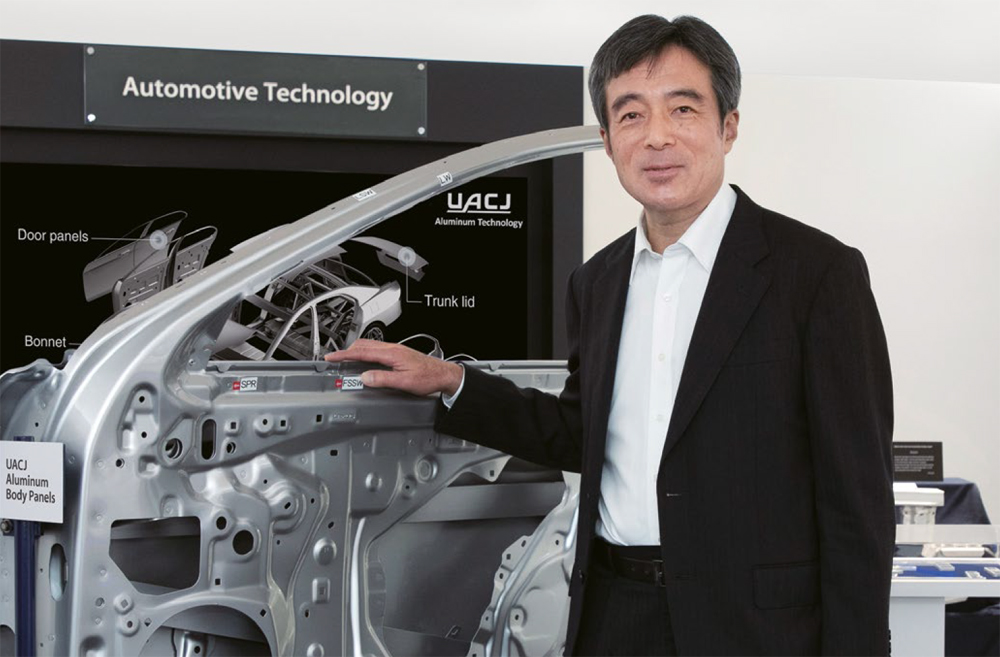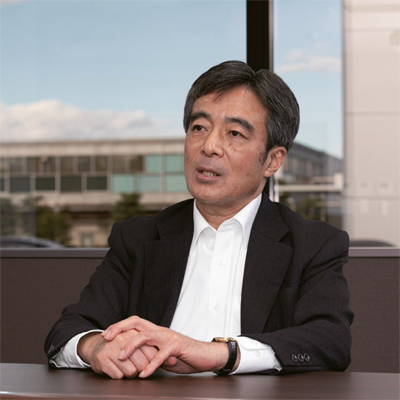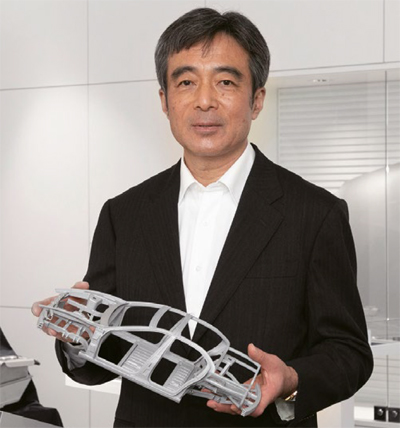
ATZ _ Hirano-san, I heard that UACJ Corporation is a company with a long history in aviation. When was it established?
HIRANO _ Well, today's UACJ was born in 2013 through the business integration of Sumitomo Light Metal Industries Ltd. and Furukawa-Sky Aluminum Corp. But our research and development began hundred years ago with the investigation on aluminum alloys for aircraft. In 1936, Dr. Isamu Igarashi, an expert of the Research Division of Sumitomo Metal Industries, Ltd., which is where our roots lie, developed Extra Super-Duralumin, ESD for short. Thanks to the invention of this lightweight and high-strength material, the performance of aircraft has improved dramatically since then, and ESD still contributes to the development of the space and aviation technology to this day.
Where is your research base located?
The R&D division is based in Aichi Prefecture in the central part of Japan, and R&D is also carried out in the USA and Thailand. UACJ's R&D Center employs 300 researchers, the largest number in the global aluminum industry.
It seems that there is no research and development base in Europe. How do you get local information from there?
The development of Japanese cars, which have won many awards in Europe, is being carried out in Japan and is supported by UACJ's R&D Center in Aichi Prefecture. We have established UACJ Extrusion Czech s.r.o., a manufacturer of extruded aluminum for heat exchangers in the Czech Republic, and UACJ Elval Heat Exchanger Materials GmbH in Düsseldorf (Germany), a company that sells aluminum for heat exchangers. Currently, we do not have a research base in Europe, so we respond appropriately to requests from Europe in Japan. And via correspondents, we collect information on European automobile technologies daily and feed it back to our research activities. I think a research base in Europe will be a future issue.
What kind of research is being done? Which lightweight design approach do you follow, especially for body panels?
The UACJ R&D Center develops products that are built on accumulated basic research on aluminum alloy design, strength, formability, corrosion resistance, etc. For automobiles, UACJ has developed Japan's frst aluminum alloy sheet for body panels and has contributed to the weight reduction of Japanese automobiles. Currently, we are working on improving the properties of 6000series aluminum alloy sheets for body panels. Our newly developed alloy features excellent formability, strength resulting from paint-baking, corrosion resistance and surface quality. UACJ is
also at the top level in the world in the development of bright aluminum alloy sheets with excellent brilliance and various functional pre-coated aluminum alloy sheets. These products also have some applications as automobile parts.
Multi-materialization is expanding in the body structure of automobiles. What kind of characteristics do you think make aluminum alloys superior to steel?
UACJ is a specialized manufacturer of rolled aluminum, but we are advancing research and development of composite techniques with CFRP and steel, etc. For example, there are joining techniques that use adhesion and friction stir welding. Due to advances in joining techniques between different materials and differential thickness joining techniques, a lightweight composite body structure centered on steel has been developed, and the all-aluminum structure is now limited to high-end vehicles. Aluminum can take advantage of its good characteristics, such as shock absorption and thermal conductivity. For these excellent properties, aluminum cannot easily be replaced by other materials, as steel has the advantages of steel, and resin has the advantages of resin. We believe that multi-materialization is an opportunity to expand the range of aluminum adoption through collaboration, rather than competition, with steel.
You claim that aluminum, steel materials and, increasingly, plastic composite materials, push each other in lightweight design efforts. What do you take into account when it comes to calculations for sustainability of these material groups?
In the design of a composite body structure, reduction of weight as well as improving crash safety and increasing vehicle dynamics are important issues. Structural materials are currently selected based on their strength properties, lightweight potential, and prices, but sustainability has become more important than ever. In recent years, it has become increasingly considerable to reduce the CO2 and environmental load at the disposal and recycling stage of life cycle assessments, and from now on, I think that citizens and users will take the initiative in selecting cars with the right materials. The aluminum material has excellent recyclable properties, and a low environmental impact during the recycling process. As a material manufacturer, we regard social responsibility and sustainability as most important aspects, and strive to reduce our environmental load at the diverse production stages.
The powertrain is becoming more electrified. How will you handle that? Are you involved in supplying electrode materials and battery housings, too?
The batteries installed in the powertrain are important for electrifcation. Therefore, UACJ manufactures aluminum foils as well as sheet, extruded, forged, and processed products. These foils are used as an electrode material for batteries, and they are a very important material for which there is no alternative with current technology. In addition, extruded aluminum shapes have optimum characteristics as a structural
material for battery housings due to their impact resistance and heat dissipation. Batteries are getting bigger and heavier to extend the driving range. We are proposing the use of extruded aluminum shapes. They are lightweight and can be made into various crosssectional shapes.

The purpose of electric mobility is mainly based on environmental regulations such as reduction of CO2 emissions. What are the advantages of using aluminum?
The benefts of using aluminum are its light weight, and also its high recyclability. Compared to refning aluminum from ore (bauxite) to make aluminum ingots, the energy required to recycle a product into aluminum ingots is only 3 %. In Japan, the public and private sectors are jointly developing more advanced recycling technology. This technology is called "upgrade recycling" that removes impurities and produces highpurity recycled aluminum ingots. By widely using and recycling rolled aluminum products, we can reduce carbon emissions and contribute to the realization of a sustainable mobility society.
What kind of product innovation do you think will be possible in the next two years or the next twenty years in aluminum technology?
UACJ has accumulated knowhow by focusing on basic research, such as development of rolled aluminum products, and based on this knowhow, we established our "Mobility Technology Center" in Aichi in October 2019, which is a department specializing in the development of automotive parts. This center promotes the development of innovative aluminum applications. In addition, when we can establish a lowcost cyclical upgrade recycling technology with a low environmental impact, the barriers using rolled aluminum will be eliminated, and the use of rolled aluminum products will explode. I think innovation will occur in the structure of mobility itself.
How do you address the problems of corrosion resistance and electrical conductivity in composite materials made with steel (iron) and aluminum?
UACJ's R&D Center has been engaged in research on corrosion mechanisms in the feld of heat exchangers for automobiles for more than 40 years, and we have accumulated a wide range of knowhow in preventing galvanic corrosion. Joining steel and aluminum parts is often used in current car body structures, so it is important to protect the joint parts from moisture, which is a corrosive factor, in the joint parts, and to verify the effects of deformation due to the differences in expansion coeffcient. For example, we have developed a mechanical joining process with insulators to avoid electrical connections, and also designed a sealing structure that prevent moisture in the parts after joining, in combination with adhesives.
UACJ manufactures the body and chassis components of the current Mazda MX-5 made of aluminum. What challenges were involved in implementing this lightweight design concept in the BMW Z4 sister model?
A typical example of the lightweight design of the MX-5 is the 7000-series aluminum alloy front bumper. The bumper is an important strength member for shock absorption in the crushable zone, and it is also the member farthest from the center of gravity of the vehicle, so weight reduction is also important to reduce the yaw moment of inertia. Based on these required performances, we developed alloys and extrusion processes, and realized the production high-strength, thin-walled hollow shapes for bumpers using 7000-series aluminum. This newly developed alloy also has an excellent weldability and is the most suitable one for lightweight and highly rigid welded structures. I believe that our development capabilities as a specialized manufacturer of aluminum materials could be very useful in the structural chassis design of high-performance roadsters such as the BMW Z4 (G29).
Which methods and tools do you use to design your aluminum sheets, for example to better determine the influences of load cases on other areas?
When using aluminum sheets for body panels, it is well-known that they have less elongation than steel sheets. At UACJ's R&D Center, we perform CAE-based press forming simulations to predict material cracks and wrinkles during pressing. The results are used to develop press die shapes that create beautiful body shapes, and improve material properties. Similarly, we are pursuing the use of the lightest and most effcient materials by applying topology optimization technology. For example, we are developing lightweight and high-rigidity aluminum panel members with differential thickness joining of thick and thin sheets. Including these technologies and the concept of sensitivity analysis, we would like to contribute to improving the crash safety performance and rigidity of the vehicle body and the degree of freedom in design for the future.
Hisano-san, thank you for this interesting interview.
 Seiichi Hirano, M. Sc., (born in 1959) is Director, Senior Managing Executive Officer of the UACJ Corporation, headquartered in Tokyo (Japan), and has been the Director of the UACJ Research & Development Division since 2020. He received his master's degree at the Graduate School of Science and Engineering of the Waseda University, Faculty of Science and Engineering in 1984. He worked first in Sumitomo Light Metal Industries, Ltd. and then moved to their R & D Center, which is a comprehensive research division for aluminum materials. In 2006, Hirano became the General Manager of the Third Department of the R & D Center, and since then he has taken the same position at several departments. From 2012, he served as the General Manager of the Manufacturing Engineering Department and the Quality Assurance Department. Hirano has extensive experience in aluminum research and development, production technology and quality control in general. He takes a leading role in managing International Conference on Aluminum Alloys (ICAA), a two-year series all over the world, next in 2022 in Toyama (Japan).
Seiichi Hirano, M. Sc., (born in 1959) is Director, Senior Managing Executive Officer of the UACJ Corporation, headquartered in Tokyo (Japan), and has been the Director of the UACJ Research & Development Division since 2020. He received his master's degree at the Graduate School of Science and Engineering of the Waseda University, Faculty of Science and Engineering in 1984. He worked first in Sumitomo Light Metal Industries, Ltd. and then moved to their R & D Center, which is a comprehensive research division for aluminum materials. In 2006, Hirano became the General Manager of the Third Department of the R & D Center, and since then he has taken the same position at several departments. From 2012, he served as the General Manager of the Manufacturing Engineering Department and the Quality Assurance Department. Hirano has extensive experience in aluminum research and development, production technology and quality control in general. He takes a leading role in managing International Conference on Aluminum Alloys (ICAA), a two-year series all over the world, next in 2022 in Toyama (Japan).